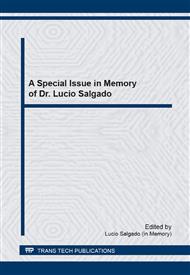[1]
Aleixo, G.T., Button. S.T.; Caram, R. Forjamento de Hastes de Próteses Femorais em liga de titânio do tipo β. 17° Congresso Brasileiro de Engenharia e Ciência dos Materiais (CBECIMat). 15 a 19 de Novembro de 2006, Foz do Iguaçu/PR. (2006).
DOI: 10.54265/fevs1311
Google Scholar
[2]
ASTM F 138-08 (2008) Standard Specification for Wrought 18 Chromium-14-Nickel-2. 5Molybdenium Stainless Steel Bar and Wire for Surgical Implants.
DOI: 10.1520/f1314-01
Google Scholar
[3]
ASTM E8/E8M (2009) Standard Test Methods for Tension Testing of Metallic Materials.
Google Scholar
[4]
ASTM F 1108(2009) Standard Specification for Titanium-6-Aluminium-4-Vanadium Alloy Castings for Surgical Implants.
Google Scholar
[5]
Blaha, J. D. Press fit femoral components. In: CALLAGHAN, J. J.; ROSEMBERG, A. G.; RUBASH, H. E. (Eds. ). The adult hip. Philadelphia: Lippincott-Raven. pp.1085-1091. (1998).
Google Scholar
[6]
Burny, F.; Donkerwoldke, M.; Muster, D. Biomaterials education: a challenge for medicine and industry in the late 1990s. Revista Materials Science and Engineering. v. A199, pp.53-59(1995).
DOI: 10.1016/0921-5093(95)09907-7
Google Scholar
[7]
Chapiro, A. Radiation chemistry in the field of biomaterials. Revista Radiation Physics Chemistry, Britain, v. 46, n. 2, pp.159-160 (1995).
DOI: 10.1016/0969-806x(95)00006-j
Google Scholar
[8]
Disegi, J.A.; Eschbach, L. Stainless steel in bone surgery. Revista Injury-international journal of the care of the injured, v. 31, pp.2-6 (2000).
DOI: 10.1016/s0020-1383(00)80015-7
Google Scholar
[9]
Hozack, W. J.; Rothman, R. H.; Eng, K.; Mesa, J. Primary cement less hip arthroplasty with a titanium plasma sprayed prosthesis. Clinical Orthopaedics and Related Research, v. 333, n. 12, pp.217-225 (1996).
DOI: 10.1097/00003086-199612000-00023
Google Scholar
[10]
Kilis, Wrighti, Jones, R.S. Change in Harris Hip Score in patients on the waiting list for total hip replacement. Ann RColl Surg. Engl. 85, 269-71 (2003).
DOI: 10.1308/003588403766275006
Google Scholar
[11]
Learmonth Id, Young C., Rorabeck C. The operation of the century: total hip replacement. Lancet. 370, 1508-19. (2007).
DOI: 10.1016/s0140-6736(07)60457-7
Google Scholar
[12]
Lima, P. M. Caracterização de revestimentos de hidroxiapatita depositados por aspersão térmica plasma sobre a liga Ti-13Nb-13Zr para aplicação em implantes dentários. Doutorado (Tese). Campinas, 2004. Universidade de Campinas (UNICAMP). Campinas.
DOI: 10.47749/t/unicamp.2004.333848
Google Scholar
[13]
Lopez A.D., Ciconelli R. M, Reis F.B., Medidas de avaliação de qualidade de vida e estadosde saúde em ortopedia. Rev Bras Ortop. 42. 355-9 (2007).
DOI: 10.1590/s0102-36162007001100002
Google Scholar
[14]
Macedo, C. A.; Galia C. R; Rosito R; PereaC.E.F.; Muller L. M, VerzoniGG etal. Abordagemcirúrgica na artroplastia total primária de quadril: ântero-lateral ou posterior. Rev BrasOrtop. 37, 387. (2002).
Google Scholar
[15]
Silva, S.G.V. Artroplastia do Quadril. Revista de Ortopedia e Traumatologia. P. 1-10. (2009).
Google Scholar
[16]
Sanada, J. T.; Avaliação da resistência e modulo de elasticidade de osso mineralizado e desmineralizado pelos testes de microtração. Mestrado (Dissertação). Bauru, 2007. Faculdade de Odontologia de Bauru. Bauru.
DOI: 10.11606/d.25.2007.tde-19062007-133051
Google Scholar


